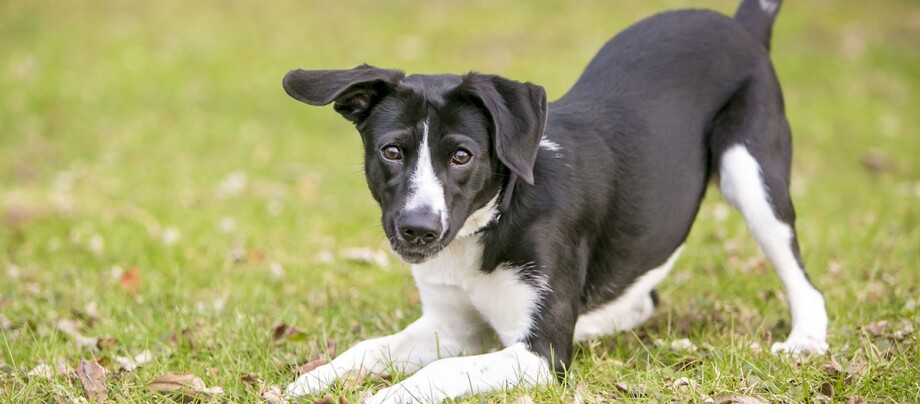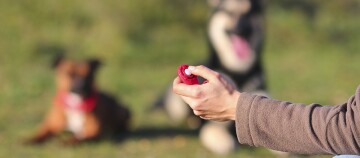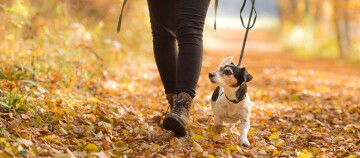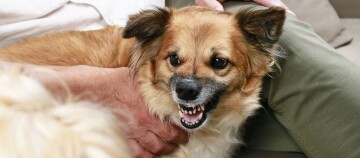Dog Body Language - How Should You Interpret Body Language in a Dog
07.10.2022 - Reading time: 2 minutes

As an experienced owner, you will instantly recognise your dog’s behaviour. Are they looking forward to going for a walk or getting fed? Are they annoyed because the cat is in their bed? Or can you immediately tell that they’ve been up to something and you haven’t yet noticed exactly what it is they’ve done? All these things can be picked up on without a single woof. Their body language changes so much that the smallest nuances in their behaviour and attitude speak volumes. Find out how to “read” your dog here.
Wordless dialogue: What does body language look like in dogs?
Dogs have a large repertoire of vocalizations: they bark, howl, growl or whine. However, the voice is only half of the communication. Most communication takes place non-verbally through facial expressions and gestures. In the absence of hands, the dog mainly uses ears and tail to “gesticulate”. In addition, the third component is general posture. The actual “language”, i.e. sound expression, receives the correct meaning only in the context with the body.
What are the levels of body language in dog behaviour?
When communicating with each other, dogs use all of the above ways to exchange information:
- Acoustic signals: barking, yelping, and howling are useful in isolation when there is no visual contact between animals (or humans and animals). For example, a search dog can summon its handler when it finds something, or a pack of dogs can maintain contact with each other.
- Gestures: posture, tail movements or the position of the ears are visual signals that can also be interpreted when the dog is standing at some distance from its counterpart. A wagging tail means something different than one held rigidly erect.
- Facial expressions: the eyes and flews in particular dominate the dog’s actual facial expression and, when viewed up close, can convey very sophisticated messages.
- Posture: posture and tension emphasize whether the dog is confident or defensive, relaxed or nervous.
Non-verbal expressions always occur in combination, while vocalizations are optional. In addition, dogs convey information among themselves via scents, so that communication between animals has an olfactory component.
How should I interpret body language in a dog?
Viewed from the snout to the tip of the tail, the following typical signals are used in dog body language:
- Head posture: an averted gaze signals peacefulness, direct eye contact self-assurance or confrontation, depending on the context. The head can be attentively raised or lowered. If the head is tilted “questioningly” to the side, the dog is unsettled and is probing the situation.
- Eyes: constricted and fixed pupils and a fixating look should be understood as a threat. A relaxed, friendly dog has large pupils and a rather gentle expression. The posture of the eyebrows also reinforces the expression – just think of the famous “Dachshund look.”
- Muzzle: the lips, corners of the mouth and teeth say a lot. The corners of the mouth being pulled back betray submissiveness; if teeth are shown, this is a threat. It is quite different when the lips are turned forward and canine teeth are slightly protruding. With such a look the dog feels relaxed. In general, a slightly open mouth is a sign of relaxation. On the other hand, if the dog “yawns” with its mouth wide open, it is not necessarily tired: it can also be a gesture of appeasement, it is excited or something does not suit it.
- Ears: depending on the breed, the dog’s ears can be a little more difficult to decipher. An animal with pronounced droopy ears, such as a basset hound, may not be able to point its ears the way a German Shepherd does. You need to look a little closer at the signs your dog gives with his ears. Ears pointed forward indicate security and attention; laid flat back, they signal fear or submission.
- Dorsal fur: An excited or aggressive dog may erect its dorsal fur. This has the optical effect of making the animal look larger and more bulky. With the “brush” up, the dog expresses annoyance or a clear threat.
- Tail: A calmly swinging tail indicates a friendly mood, but also excitement or even aggression, depending on the speed of the tail. Rigidly set or somewhat trembling, it signals attention or annoyance. Being tucked between the hind legs indicates fear. Here, too, there may be “communication problems” in breeds with short tails. With such dogs then the whole rear end wobbles.
- General mood: the “change” of the body size plays a role. If the dog makes itself big or “puffs up,” it is self-confident or perhaps wants to impress an opponent. If the dog tries to appear smaller (for example, by crouching down) or bending his hind legs, he is insecure and fearful. If he lies down on his back and reveals his belly, it is a gesture of submission. If, on the other hand, he lowers his front body and stretches up his hindquarters, accompanied by tail wagging, it is an invitation to play.
What are the misunderstandings about dog body language?
When interacting with your dog, you should always try not only to pay attention to his body signals, but also respond to them adequately. Some elements of our human body language are interpreted by the dog completely differently than we intend. For example, be careful not to look a dog directly in the eye unnecessarily: from the dog’s point of view, this is a threatening gesture. The same applies to smiling: Even if you mean well and smile brightly at a dog, it may misunderstand the human “show teeth” and “pull back lips”. Do not touch a dog unexpectedly from behind and do not simply bend over it – this can also be interpreted as an unfriendly gesture on the part of the sniffer nose. By the way – behavioural researchers at the University of Florida have found out that the transfer performance of dogs in interpreting the facial expressions of familiar people is more differentiated than vice versa.


